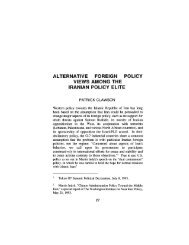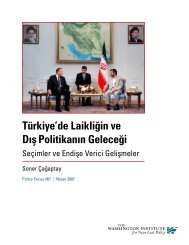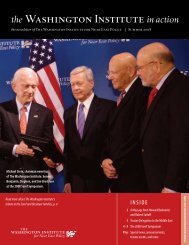Michael Eisenstadt David Pollock How the United States Benefits ...
Michael Eisenstadt David Pollock How the United States Benefits ...
Michael Eisenstadt David Pollock How the United States Benefits ...
Create successful ePaper yourself
Turn your PDF publications into a flip-book with our unique Google optimized e-Paper software.
ASSET TEST<br />
some circumstances. For instance, reverse osmosis<br />
is well suited for desalinating brackish water for<br />
agricultural or industrial uses—<strong>the</strong> major uses<br />
of water worldwide—as opposed to desalinating<br />
seawater to produce drinking water.<br />
Israel has also succeeded in sharply cutting <strong>the</strong><br />
costs of desalination. Technical and organizational<br />
innovations, including a government guarantee<br />
to purchase all desalinated water produced, have<br />
reduced <strong>the</strong> energy input required for each cubic<br />
meter of water to just 3.5 kilowatt hours (about 40<br />
cents’ worth of electricity at <strong>the</strong> current average U.S.<br />
price). The total cost of Israeli desalinated water<br />
is expected to be 55 cents per cubic meter next<br />
year—a dramatic drop from two dollars per cubic<br />
meter a decade ago. As a result, Israel may be able<br />
to increase its exports of desalination equipment<br />
and proprietary processes to foreign customers—<br />
such as India and China, as well as African and<br />
o<strong>the</strong>r countries confronting desertification, rapid<br />
urbanization, or o<strong>the</strong>r water security challenges. 58<br />
Indeed, one indicator of Israel’s niche capabilities<br />
in this field is growing Chinese interest in <strong>the</strong>m.<br />
At <strong>the</strong> sixth-annual water technology “WATEC<br />
Israel” exhibition in Tel Aviv in November 2011,<br />
for instance, prospective buyers from China<br />
outnumbered all o<strong>the</strong>r individual-country<br />
delegations, accounting for more than two hundred<br />
people. 59 Most recently, in early 2012, <strong>the</strong> Israeli<br />
and Chinese finance ministers signed a deal in<br />
Beijing for $300 million in Israeli water technology<br />
exports to China. 60<br />
Israeli researchers have also made breakthroughs<br />
that have permitted productivity increases for plant<br />
and dairy farmers and aquaculturists. For example,<br />
Israel’s 100,000 dairy cows are <strong>the</strong> most productive<br />
in <strong>the</strong> world, due to scientific breeding and feeding<br />
techniques. 61 While <strong>the</strong>se innovations may be<br />
of limited direct use to U.S. dairy ranchers, who<br />
sometimes suffer from overproduction, <strong>the</strong> Volcani<br />
Agricultural Research Center outside Tel Aviv and<br />
o<strong>the</strong>r Israeli institutions hold international courses<br />
to share <strong>the</strong>ir advances with hundreds of students<br />
from developing countries—and even from<br />
developed countries (such as France). 62 Similarly,<br />
in early 2012, ano<strong>the</strong>r Israeli agricultural research<br />
center reported that it had doubled average milk<br />
production per cow at a model farm in China, from<br />
5,000–6,000 liters to 11,500 liters per year. 63 And<br />
on a larger commercial scale, in Vietnam, ten Israeli<br />
companies are managing 30,000 cows in new,<br />
scientific dairies slated to produce 300 million liters<br />
of milk annually. 64<br />
In <strong>the</strong> private sector, Israeli researchers have<br />
developed a model that uses satellite imagery to<br />
enable farmers to take advantage of microclimates<br />
to maximize crop yields. 65 Likewise, an Israeli<br />
software manufacturer has created an internetbased<br />
system that advises farmers on optimal<br />
planting, irrigation, harvesting, and marketing<br />
times, <strong>the</strong> best feed mix for livestock, and ideal<br />
temperature control and storage procedures,<br />
depending on local conditions; this manufacturer<br />
has joined with IBM to market <strong>the</strong> product<br />
worldwide. 66 And Israel has developed a reputation<br />
for excellence in intensive aquaculture; raising fish<br />
in <strong>the</strong> desert has become an Israeli specialty, and<br />
Israel has partnered with Germany and Kenya<br />
to create plans for a wastewater treatment and<br />
aquaculture program for Lake Victoria—<strong>the</strong> largest<br />
lake in Africa, which provides a livelihood for five<br />
million people. 67<br />
These innovations could enable Israel to help<br />
drought-stressed countries (perhaps including<br />
neighboring Arab states) build climate-adaptive<br />
infrastructures and enhance water management<br />
capabilities, making <strong>the</strong>m more resilient in an age of<br />
disruptive climate change. 68 Indeed, in April 2012,<br />
<strong>the</strong> U.S. Agency for International Development<br />
(USAID) and MASHAV (Israel’s Agency for<br />
International Development Cooperation) signed<br />
a memorandum of understanding to increase<br />
cooperation on food security in four East African<br />
countries (Uganda, Ethiopia, Tanzania, and<br />
Rwanda), while <strong>the</strong> next month, MASHAV<br />
signed a memorandum of agreement with <strong>the</strong> UN<br />
Industrial Development Organization (UNIDO)<br />
to advance, inter alia, water management and<br />
38 sTraTegic rePorT 7 | eisensTadT, <strong>Pollock</strong>













